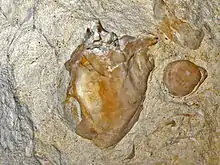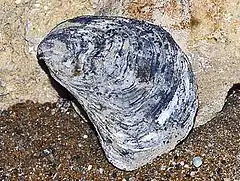Neopycnodonte
Neopycnodonte is a genus of marine bivalve molluscs belonging to the family Gryphaeidae.[2][3]
| Neopycnodonte | |
|---|---|
 | |
| Fossil shell of Neopycnodonte navicularis with a small Terebratulid valve from Pliocene of Italy | |
| Scientific classification | |
| Kingdom: | Animalia |
| Phylum: | Mollusca |
| Class: | Bivalvia |
| Order: | Ostreida |
| Family: | Gryphaeidae |
| Genus: | Neopycnodonte Stenzel, 1971 [1] |
This genus is very well represented in the fossil record, however the number of living species is very few. Fossil specimens of Neopycnodonte species possibly dating as old as about 60 million years (Paleocene). Extant species have been recorded as fossils from the Miocene to the Quaternary (from 20.43 to 0.012 Ma).[4][5]

Description
This genus includes deep-sea giant oysters with shells measuring up to 30 cm. The shells are usually brittle, inequivalve, with a left convex valve cemented to a substrate, while the right non-cemented one is flat or slightly concave. These bivalves can live for several centuries.[6][7]
Distribution and habitat
While about 25 million years these mollusks formed large colonies near the coast, for unknown reasons they migrated to deeper waters. They usually live in the Mediterranean canyons or along the continental margins at depths of 350 m to 750 m.[8][9]
Species
Species within the genus Neopycnodonte include:[2]
- Neopycnodonte cochlear (Poli, 1795)
- †Neopycnodonta navicularis Brocchi 1814 [5]
- Neopycnodonte zibrowii Gofas, Salas & Taviani, 2009
References
- Stenzel, 1971 1971 in Treatise on Invertebrate Paleontology Mollusca 6, vol. 1, Bivalvia (Digital Treatise) online
- WoRMS
- ITIS
- Fossilworks
- N. navicularis at Fossilworks
- 507 ans : l'âge record d'une palourde, morte en 2006
- Ostras gigantes en Cádiz
- Marie-Claire Fabri, Laura Pedel Biocénoses des fonds durs du bathyal et de l’abyssal Archived 2014-12-24 at the Wayback Machine
- Marine Bivalve Shells of the British Isles
| Wikispecies has information related to Gryphaeidae. |